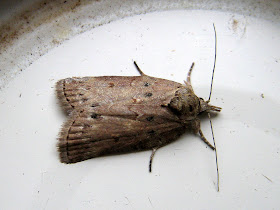Last night's catch of 23 species was pleasing including this that I think is an Oak Nycteoline (about 15mm in length).
The most abundant species with 4 individuals was November moth agg. With one individual I tried to narrow it down more.
I think from the underside of the abdomen it is probably a November moth?
The catch also included what seemed to be a fairly late Brimstone.
Andy Newbold, Sibford Ferris, Oxon.




Yes to Oak Nycteoline. With the Novemnal, I don't think you can tell from the underside picture. Needs a few scales rubbed off to see the octavals clearly.
ReplyDeleteThank you. I'll go back to recording November agg.
ReplyDeleteYou can see the octavals and the valvae do have a spike on the side, so I'd go back to a November moth. Martin is right, it would have been easier with a few scales removed, then the octavals become clearer. I use a slightly wetted fine artists paint brush.
ReplyDeleteThank you I will have a go next time I catch one. There seem to be a few around at the moment and with small catches I have a bit more time to spend looking more carefully.
ReplyDeleteSorry but nothing can be seen clearly here and I can't accept this as a record of November Moth. In order to appreciate the differences between the males of the 3 species of Epirrita that can be separated on external genitalic features, it is necessary to look at several of each before becoming confident, especially as the distance between the octavals varies somewhat in dilutata and christyi, and looking at different magnifications can be deceptive. This does not mean taking a series of photographs and then releasing the moths. The differences are well illustrated here http://mothdissection.co.uk/species.php?Tx=Epirrita_dilutata and also here http://www.mothscount.org/uploads/Difficult_species_guide_page_30.pdf (with explanation). You don't say whether this moth was still alive. It is much trickier to remove scales on a live moth than on a dead one, although you can do it with practice by holding the wings between finger and thumb. Even then the tail end may not stay sufficiently still, so best to start on specimens that are quiet. I will be happy to take samples of male Epirrita species from VC 23 for determination/confirmation, especially from sites where there has been no determination to species. November Moth has been flying for a week or so, Pale November Moth will be just about starting. Look out for Autumnal Moth at the end of this month and into November. These will be in better condition than the others and often well-marked.
ReplyDeleteNo problem I will leave my records of the ones caught so far this year as November agg. This was a living moth. I will keep some specimens for examination from future catches as I would imagine there has not been any recent determination of species from this area (SP33).
ReplyDelete